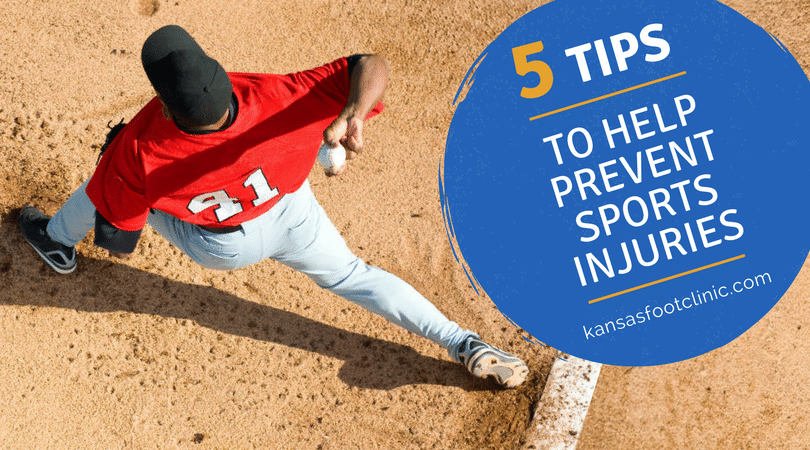Don’t Spring into a Sport Injury!
Summer is almost here, and that means many of us Central Kansas residents are emerging from our semi-hibernation!
Warmer temperatures. More sunshine hours. Fewer bitterly cold mornings and evenings. Yeah, it’s probably time to start running again, right?
Of course, for you it might not be running. Maybe it’s tennis on the weekends. Or rec league softball. Or hey, any of the other great offerings from the McPherson Recreation Commission—basketball, flag football, soccer, dodgeball … you get the idea.
Now, it probably won’t surprise you that we’re very much in favor of our patients staying active and getting plenty of exercise! The benefits are just about endless. More energy. Better mood. Lower risk of health complications. Reduced stress levels.
And, if you already have a health condition you’re managing—diabetes, for example, or poor circulation—regular activity is key to helping you alleviate pain and prevent the conditions from progressing further.
But hold up a sec.
While sports and exercise are great for your body, they also open up the possibility of injury. That’s not so great, obviously.
The Right Way to “Spring” into Spring Sports
Although sport injuries can (and do) happen year-round, we often see an increase in injury rates during the spring and early summer.
Why?
The simple explanation is that people are doing too much, too soon.
Let’s face it—most of us tend to cut back on our physical activity level during the winter. It’s just not always very pleasant outside, so we give up our favorite outdoor sports for a while. Maybe we still make it to the gym here or there, or have an indoor gym where we can play some basketball.
But when you don’t have the freedom to just head out for a run whenever you feel like it—at least not without braving some nasty weather—most of us give into the temptation, put the running shoes back in the closet, and queue up the next episode of whatever we’re watching on Netflix.
When spring rolls around again, a lot of us start to think, “Oh no, I have to make up for lost time!”
But if you don’t give your body time to adjust before you spring back into action, you’re far more likely to bend, stretch, and break it. You can’t go from the couch to mid-season form in a day!
We encourage all our athletes of any age—youth players to adult rec leaguers—to start slowly. That applies whenever you’re restarting activity after a long break or switching to a new sport or exercise program (which may test different groups of muscles and joints than your previous sport).
What does that look like?
Well, if you’re badly out of shape, it might be a good idea to start exclusively with low-impact cardio, stretching, and weight training before doing any sport-specific drills or training. You should shoot for 30 minutes of moderate intensity workouts a couple of times per week—or, if that’s too much, whatever you can handle at first.
Once you’re able to handle 30 minutes, you can start to increase the intensity gradually week to week. That could be more training sessions, longer duration, more mileage, or more sport-specific training. Just try to keep the increases at a manageable level—10 to 15 percent week over week at most.
Other Injury Prevention Tips
Easing your body into activity is particularly relevant for seasonal athletes, but it isn’t the only good suggestion to follow when it comes to limiting your injury risk.
- Wear good gear. Make sure your shoes are in good shape and were specifically designed for your sport of choice—running, hiking, basketball, tennis, etc. All-purpose athletic shoes may not be adequate to handle the specific forces and risks of every sport equally well. Wear any additional protective gear that may be necessary for your sport.
- Warm up before exercise. Don’t skip the warm-up! A little light intensity cardio and stretching before a game or strenuous workout will get your muscles loose and warmed up without exposing them to significant risk.
- Stay hydrated. Dehydration is a common precursor to poor athletic performance and increased injury risk. Make sure you put away a couple of glasses’ worth of water an hour or two before your activity, and then drink regularly throughout the game or workout.
- Cross train. Vary your sports or workouts so that you aren’t always targeting the same joints, muscle groups, etc. Too much of one type of activity can lead to overuse injuries like heel pain, stress fractures, and shin splints. If you find your feet hurting, it may be a good idea to cut back on your impact exercise and do some cycling or swimming (for example) instead.
- Don’t play through pain. If something hurts, you need to do something about it—and that “something” isn’t “walk it off” or “push through it.” A little bit of aching is one thing, but if you’re in genuine pain, it means you’ve already been injured, and continuing to ignore the problem will only cause it to worsen.
Armed with the above tips, we certainly hope you’re able to enjoy an awesome (and awesomely fun) spring sports season without getting hurt.
If, however, you do develop pain and discomfort in your feet or ankles—whether that takes the form of an acute injury (like a sprain or fracture) or chronic overuse pain—stop by the Community Foot Clinic of McPherson.
Our team can provide effective sports injury care, including advanced options like MLS laser therapy for those who need to get back on their feet as quickly as possible. To schedule an appointment at one of our three convenient offices—McPherson, Herington, or Hillsboro—give us a call today at (620) 241-3313.
© Community Foot Clinic of McPherson. All Rights Reserved.
Privacy Policy | Terms & Conditions
Web Design by CP Solutions
Marketed by VMD Services


